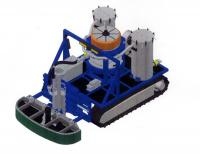Efforts to clean up radioactive particles discharged to sea from Dounreay will be bolstered this month by the addition of a large crawler robot.
 |
The device is about the the same size as a small bulldozer, Dounreay Site Restoration Ltd (DSRL) said, and includes a two metre-wide detector capable of pinpointing particles buried up to 60 centimetres in sediment. It will be operated via a 500 metre cable from a control room on a barge moored 500 metres offshore.
The robot is supplied by Land & Marine, and the detector by Nuvia. A staff of about 20 Land & Marine workers will operate in shifts around the clock to control and cover its assigned area of 12.5 hectares of seabed.
The particles the team are looking for came from handling of used nuclear fuel from research reactors before reprocessing and recycling. Aluminium cladding on fuel from the Dounreay Materials Test Reactor and similar exported units had to be removed manually and this resulted in a build up of debris at the bottom of storage ponds.
A system of settling tanks had been used to remove these materials before any discharges to sea, but the detection of a particle during routine nearby monitoring in 1983 revealed the process had been inadequate. Filters were added in 1984, clean-up began and in 2007 the UKAEA was fined £140,000 ($215,000) after admitting that it had not used 'all reasonable practical means to prevent the release of particles'.
Since their release the particles have behaved like grains of sand, with some being buried in the seabed and others transported to nearby beaches. To date some 1100 have been recovered. A smaller underwater robot found 115 particles in a 7.5 hectare area last year with 28 of these presenting a 'significant' risk to health.
DRSL predicts the new robot will find about 700 particles in its sweep of the area, of which it thinks about 200 could be 'significant'. The robot will collect the particles in two on-board tanks that will be emptied onto the control barge. Recovered particles will be returned to Dounreay for proper management.
Researched and written
by World Nuclear News





_70761.jpg)
_55530.jpg)
_42372.jpg)
_76087_55556.jpg)




